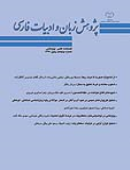از اندامواژه صورت تا حرف ربط
محورهای موضوعی : Research in Iranian classical literature
صدیقه پورملکی
1
,
مجتبی منشیزاده
2
![]() ,
ارسلان گلفام
3
,
فردوس آقاگل زاده
4
,
ارسلان گلفام
3
,
فردوس آقاگل زاده
4
1 - دانشگاه ازاد اسلامی واحد علوم و تحقیقات تهران
2 - علامه طباطبایی
3 - دانشگاه تربیت مدرس
4 - تربیت مدرس
کلید واژه: دستوریشدگی واژه قاموسی تغییر معنایی تغییر مقولهای اندامواژهها,
چکیده مقاله :
دستوری شدگی فرایندی است که که طی آن یک صورت واژگانی به یک عنصر دستوری تبدیل میشود. به کمک این فرایند، تغییرات معنایی یک تکواژ قاموسی در کنار برخی تغییرات مقوله ای و آوایی به عملکرد ساختاری در حوزه نحو میانجامد و سازههای واژگانی سابق برای بیان مفاهیم دستوری انتزاعی مانند زمان، وجه و نمود به خدمت گرفته میشود. از جمله منابع واژگانی هر زبانی، اندامواژهها هستند که شبکه معنایی بزرگ و بسامد کاربردی فراوانی دارند. مشارکت این دسته از واحدهای واژگانی آزاد در فرایند دستوری شدگی به وسیله پژوهشگران مختلفی گزارش و نشان داده شده است که برخی اندام واژهها با حرکت در پیوستار دستوری شدگی و دور شدن از معنای مرکزی خود به حرف اضافه تبدیل شده اند. مقاله حاضر بر آن است در چارچوب عملکرد این فرایند به جستوجوی اندام واژه «صورت» و الگوی تغییرات این واحد قاموسی در نظام زبان فارسی بپردازد و بر این اساس صورتهای بسیط، مشتق و مشتق مرکب اندام واژه صورت بیان شده در «فرهنگ کنایات سخن» انوری (1383) و فارس نت(1) را در راستای پاسخ به پرسش هایِ ذیل بررسی کرده است: 1- پیوستار تغییرات درباره دستوری شدن اندام واژه صورت چگونه است؟ 2) پیامدهای معنایی، واژنحوی و مقوله ای دستوری شدن این اندام واژه چیست؟ کاوش در دادهها نشان داده که این واحد قاموسی نیز مانند دیگر اندام واژهها در فرایند شرکت نموده و جلو رفته و پس از اشاره به اندام صورت (معنای مرکزی)، دچار بسط معنایی و تنزل پایگانی شده و در ساختها و نقشهای جدیدی حضور یافته است. ایستگاه پایانی تغییرات این اندام واژه، عملکرد دستوری به مثابه حرف ربط مرکب ناهمپایه ساز برای بیان شرط و تقابل است. در جریان این تحولات از معنای مرکزی خود دور و دورتر شده تا جایی که در حالت حرف ربط مرکب، دیگر اثری از محتوای قاموسی اولیه و اشاره به اندام صورت نیست.
Grammaticalization is a process through which a lexical item changes into a grammatical morpheme. Semantic changes of a free morpheme along with the categorical and phonological changes result in structural function in the syntax of a language, and the former lexical items are used to express abstract grammatical concepts such as tense, aspect, and mood. In all languages, body part words as a part of lexical sources are very frequent, and have a vast semantic network. The role of these free lexical items in the process of grammaticalization has been documented by various researchers, and it has been shown that some of the body part words have been changed into adposition by moving through the continuum of grammaticalization and after a change in their core meaning. This research tries to investigate the body part word "face" and the pattern of changes in this free lexical item in Persian language system within the framework of the grammaticalization process. To do so, the different simple, derived and derived compound forms of "face" in Anvari Allegory Dictionary(1383) and FarsNet have been studied to answer the following questions: 1)what is the continuum of the changes in body part word "face" in the process of grammaticalization, and 2) what are the semantic, morphosyntactic, and categorical outcomes of grammaticalization of this word? The results show that this word has undergone the grammaticalization process like other body part words and even progressed more. This word not only refers to "face" (core meaning), it has also undergone semantic generalization and hierarchical pejoration, and participated in new structures and functions. The ending point of changes of this face is its function as compound subordinate conjunction in conditional forms and contrastive expressions. This word has gone so beyond its core meaning as subordinate conjunction that no sign of the former core meaning as body part word "face" is available.
